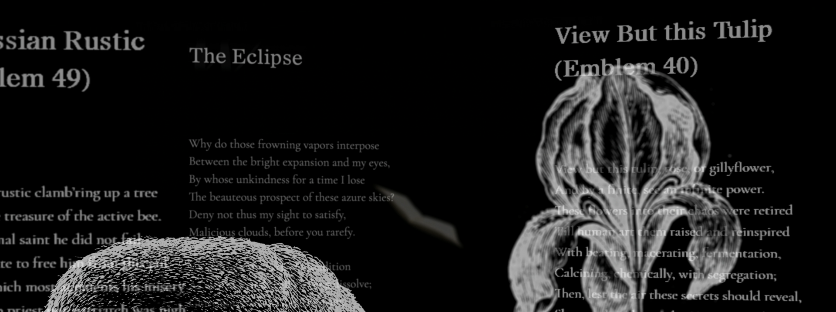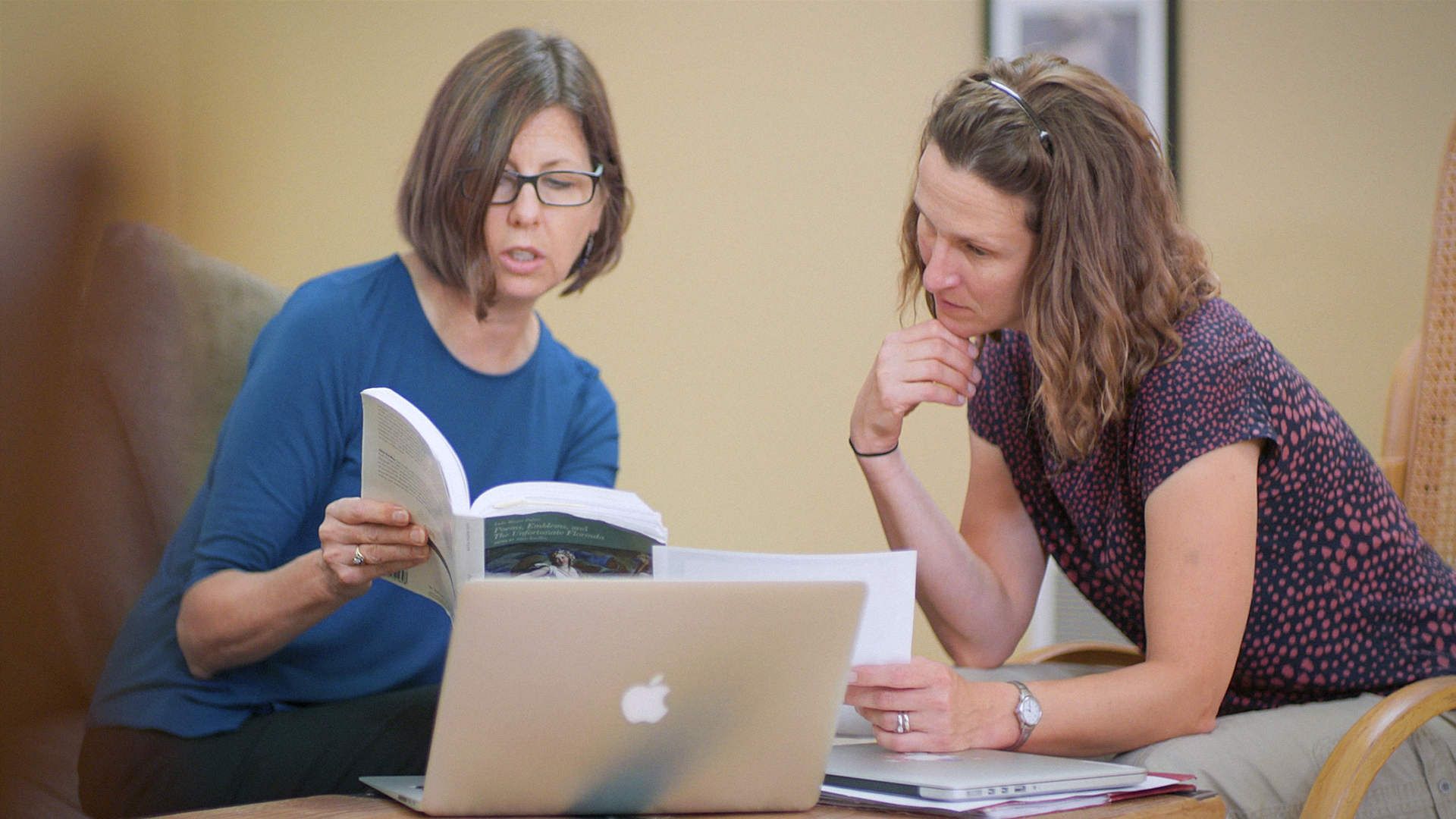
The Pulter Project: Poet in the Making
A collaborative global effort to elevate the works of a long-lost poet takes root at Weinberg College
By Rebecca Lindell
A mother of 15 scribbles away in her remote estate in 17th-century England, amassing more than a hundred poems touching on science, mourning and the nature of being.
The poems are remarkable in their scope and sophistication. They explore revolutionary concepts in physics and astronomy. They challenge presumptions about how women thought and wrote at the time.
The poet, Hester Pulter, compiles her work into a single, leather-bound book. A generation passes, and a few more words are added by an anonymous reader who records Pulter’s family tree.
For nearly 300 years, the book sits on bookshelves or in the attic, seemingly unread. Somehow, it makes its way to London, where in 1975, it is purchased at an auction by a former mayor of the city.
In 1996, a graduate student is poring through the library stacks at the University of Leeds and discovers the manuscript. Flipping through the yellowed pages, he begins to suspect he is holding a masterwork in his hands.
And then the poems remain unpublished for nearly two more decades.
Rescued from the archives
Pulter’s work was finally brought to light by Alice Eardley, a British researcher who published a scholarly edition on the poet in 2014. Then, almost as soon as the book was published, it fell out of print, and Pulter risked falling into obscurity — again.
But the story doesn’t end there. In fact, thanks to the efforts of Wendy Wall, the Avalon Professor of the Humanities and a professor of English at Weinberg College, Leah Knight, an associate professor of English at Canada’s Brock University, and the College’s Media and Design Studio, Pulter’s poetry has re-entered the world on a larger stage than the poet ever could have imagined. In doing so, it has united scholars around the globe in a diligent effort to expose Pulter’s work and potentially elevate it to canonical status.
“Hester Pulter is not commonly known today, but she will be,” Wall predicts. “I’m confident that she is entering the canon, and I’m excited about being part of that process.”
Wall, a scholar of early modern English literature, first encountered Pulter in 2015, when she was asked to write a piece about female authorship in the early modern period. She picked up Eardley’s book and came across the following lines:
For I no liberty expect to see
Until to atoms I disperséd be;
Then being enfranchised, free as my verse,
I shall surround this spacious universe,
Until by other atoms thrust and hurled,
We give a being to another world.
— from “Why Must I Thus Forever Be Confined,” poem 57, The Pulter Project
“I just fell in love with this poem,” Wall says. “I could not believe that a woman, living in this somewhat isolated estate in 17th-century England, knew so much about things that you would think only a man trained at a formal university would know about — things like astronomical findings and recent work in  physics. I simply didn’t expect someone in her situation to have known so much about poetic writing, and to have written so many poems, and to know so much about cutting-edge science.”
physics. I simply didn’t expect someone in her situation to have known so much about poetic writing, and to have written so many poems, and to know so much about cutting-edge science.”
Intrigued, Wall (pictured, left) reached out to fellow early modern scholar Knight (pictured right) to co-host an experimental seminar on the topic of discoveries in the literary archives. “What do you do with them?” Wall wondered.
A poet in the making
Pulter’s poetry was not the sole focus of the workshop, but the seminar participants were so enthused about her work that Wall began to think about how to bring Pulter’s poetry to a wider audience. Inspired by the projects undertaken by other humanities scholars in the MAD Studio, Wall and Knight proposed the creation of a website that would explore the many dimensions of Pulter’s work and expose her to the widest audience possible.
And thus The Pulter Project: Poet in the Making was born.
Spurred by a W Award — the College’s grant program for innovative research — the project rapidly took shape, with the creation of the website and an international team of nine core scholars working to exhume Pulter’s body of work.
The website, which debuted in November, presents scholars, students and other visitors with a pioneering editing format. Instead of a single “authorized” edition, the website offers readers the chance to experience Pulter’s poetry on multiple levels. They can read the poems as they were originally written, without supplemental notes or additional context. They can opt to see annotated versions with either cursory notes or more in-depth explanations. They can see how two different scholars have edited and “framed” each poem. They can look at the original manuscript pages. And those with a hunger for even more context can click on “curations” — visual images and other content that provide greater insight into the world in which the poetry was written.
“There are many things you can do in a digital platform that you can’t do in a book platform, because of the cost,” Wall notes. “You can’t show four versions of every poem for 120 poems. And you also can’t continually update it to include new findings and new ways of thinking about the material. So the digital platform offered this wonderful collaborative working environment.”
“A comet burning through space”
It is an approach that aligns with the spirit of Pulter, who was clearly fascinated by the mobility of form.
“She thinks about the disintegration of her body into parts – into molecules and atoms,” Wall notes. “But she didn’t see this as a depressing phenomenon, which a lot of people at the time did. She saw it as exhilarating: the idea that you could imagine your body disintegrating and turning into air; that your components — the liquids in your body, your physical being — could transmutate into other parts of the universe and become stars and planets. That you might dissolve down to dust, but that your dust might then rise up into air and eventually sing in heaven, free from the constraints of human form.”
“She thought of herself sometimes as a comet burning through space, sometimes describing the world from the perspective of the moon, which leading astronomers of the day were also doing. These are just really extraordinary ways of thinking about life.”
Pulter’s musings on grief — a subject with which she was well acquainted — were also unique for her era. Married at age 15, she went on to birth eight daughters and seven sons. She buried all but two of them.
At a time when grief was viewed as an emotion to be “moderated” and suppressed, Pulter refused to bury her sorrow. Her poetry defiantly recalls the body of her dead daughter Jane in meticulous detail and declares, two years after Jane’s death, that her “sad heart, for her still pining, dies.”
“Women probably didn’t like having preachers tell them that they couldn’t deeply feel a loss,” Wall says. “At the same time, because they routinely experienced death in childbirth and the loss of children, women were expected to take more of a leadership role around grief. I think Hester Pulter wanted to use poetry as a means of exploring the frustration of not being able to imagine oneself in a state of loss.”
A global collaboration
Pulter’s broad scope makes the website the perfect medium for exploring her work and expanding her reach. Humanities scholars around the world — from the United States to New Zealand to Canada to the United Kingdom — are now working to analyze and elevate the poet’s literary legacy.
As the site attracts new collaborators, a more complete portrait of Pulter is emerging. Just recently, in fact, a researcher in Australia discovered Pulter’s marriage record.
“The title of the site is ‘The Pulter Project: Poet in the Making,’ and we want people to see how a poet is made, how her poems are made, and how that’s an ongoing process that’s going to continue over time,” Wall says. “What a great opportunity to not only show people her work, but how we make poets when we introduce them to readers: we edit them, we pick out words to annotate, we select certain poems to put into anthologies, and when we are doing so, we are creating a picture of how to read a poet, and a lens through which you read them.”
It is an approach in keeping with the spirit of Pulter, who celebrated the ways in which her physical form would eventually diffuse into the universe.
“We’re taking what looked like static pieces of paper and translating them into something that other people can participate in and change over time,” Wall says.
“I think Pulter would have appreciated that. Seeing her poetry taking on a new form would have been fully in accordance with what she wrote about.”
Pictured: Weinberg College professor of English Wendy Wall (left) and Leah Knight, associate professor of English at Brock University.
Back to top